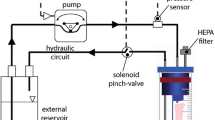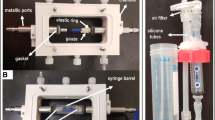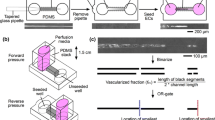Abstract
Dynamic mechanical conditioning is investigated as a means of improving the mechanical properties of tissue-engineered blood vessel constructs composed of living cells embedded in a collagen-gel scaffold. This approach attempts to elicit a unique response from the embedded cells so as to reorganize their surrounding matrix, thus improving the overall mechanical stability of the constructs. Mechanical conditioning, in the form of cyclic strain, was applied to the tubular constructs at a frequency of 1 Hz for 4 and 8 days. The response to conditioning thus evinced involved increased contraction and mechanical strength, as compared to statically cultured controls. Significant increases in ultimate stress and material modulus were seen over an 8 day culture period. Accompanying morphological changes showed increased circumferential orientation in response to the cyclic stimulus. We conclude that dynamic mechanical conditioning during tissue culture leads to an improvement in the properties of tissue-engineered blood vessel constructs in terms of mechanical strength and histological organization. This concept, in conjunction with a proper biochemical environment, could present a better model for engineering vascular constructs. © 2000 Biomedical Engineering Society.
PAC00: 8719Rr, 8714Ee, 8718-h, 8768+z
Similar content being viewed by others
REFERENCES
1_ Barocas, V. H., T. S. Griton, and R. T. Tranquillo. Engineered alignment in media equivalents: magnetic prealignment and mandrel compaction. J. Biomech. Eng.120(5):660-666, 1998.
2_ Burridge, K., K. Fath, T. Kelly, G. Nuckolls, and C. Turner. Focal adhesions: transmembrane junctions between the extracellular matrix and the cytoskeleton. Annu. Rev. Cell Biol.4:487-525, 1988.
3_ Eastwood, M., R. Porter, U. Khan, G. McGrouther, and R. Brown. Quantitative analysis of collagen gel contractile forces generated by dermal fibroblasts and the relationship to cell morphology. J. Cell Physiol.166(1):33-42, 1996.
4_ Eastwood, M., V. C. Mudera, D. A. McGrouther, and R. A. Brown. Effect of precise mechanical loading on fibroblast populated collagen lattices: morphological changes. Cell Motil. Cytoskeleton40(1):13-21, 1998.
5_ Ehrlich, H. P., K. M. Borland, K. E. Muffly, and P. F. Hall. Contraction of collagen lattice by peritubular cells from rat testis. J. Cell. Sci.82:281-294, 1986.
6_ Fung, Y. C. Bioviscoelastic solids: collagen. In: Biomechanics; Mechanical Properties of Living Tissues, 2nd ed. New York: Springer, 1993. pp. 261–262.
7_ Gillery, P., F.-X. Marquart, and J.-P. Borel. Fibronectin dependence of the contraction of collagen lattices by human skin fibroblasts. Exp. Cell Res.167(1):29-37, 1986.
8_ Girton, T. S., T. R. Oegema, and R. T. Tranquillo. Exploiting glycation to stiffen and strengthen tissue equivalents for tissue engineering. J. Biomed. Mater. Res.46(11):87-92, 1999.
9_ Girton, T. S., T. R. Oegema, E. D. Grassl, B. C. Isenberg, R. T. Tranquillo. Mechanisms of stiffening and strengthening in media-equivalents fabricated using glycation. J. Biomech. Eng., accepted for publication.
10_ Gotwals, P. J., G. Chi-Rosso, V. Lindner, J. Yang, L. Ling, S. E. Fawell, and V. E. Koteliansky. The alpha1beta1 integrin is expressed during neointima formation in rat arteries and mediates collagen matrix reorganization. J. Clin. Invest.97:2469-2477, 1996.
11_ Hirai, J., K. Kanda, T. Oka, and T. Matsuda. Highly oriented, tubular hybrid vascular tissue for a low pressure circulatory system. ASAIO J.40(3):M383-388, 1994.
12_ Hirai, J. and T. Matsuda. Self-organized, tubular hybrid vascular tissue composed of vascular cells and collagen for low-pressure-loaded venous system. Cell Transplant4(6):597-608, 1995.
13_ Kanda, K., and T. Matsuda. Mechanical stress-induced orientation and ultrastructural change of smooth muscle cells cultured in three-dimensional collagen lattices. Cell Transplant3(6):481-492, 1994a.
14_ Kanda, K., and T. Matsuda. In vitro reconstruction of hybrid arterial media with molecular and cellular orientations. Cell Transplant3(6):537-545, 1994b.
15_ Kanda, K., and T. Matsuda, and T. Oka. In vitro reconstruction of hybrid vascular tissue. Hierarchic and oriented cell layers. ASAIO J.39(3):M561-565, 1993.
16_ Langelier, E., D. Rancourt, S. Bouchard, C. Lord, P.-P. Stevens, L. Germain, and F. A. Auger. Cyclic traction machine for long-term culture of fibroblast-populated collagen gels. Ann. Biomed. Eng.27(1):67-72, 1999.
17_ Lee, R. T., F. Berditchevski, G. C. Cheng, and M. E. Hemler. Integrin-mediated collagen matrix reorganization by cultured human vascular smooth muscle cells. Circ. Res.76(2):209-214, 1995.
18_ L'Heureux, N., L. Germain, R. Labbé, and F. A. Auger. In vitro construction of a human blood vessel from cultured vascular cells: a morphologic study. J. Vasc. Surg.17(3):499-509, 1993.
19_ L'Heureux, N., S. Paquet, R. Labbe, L. Germain, and F. A. Auger. A completely biological tissue-engineered human blood vessel. FASEB J.12(1):47-56, 1998.
20_ Matsuda, T., T. Akutsu, K. Kira, and H. Matsumoto. Development of hybrid compliant graft: rapid preparative method for reconstruction of a vascular wall. ASAIO Trans.35(3):553-555, 1989.
21_ Niklason, L. E., J. Gao, W. M. Abbott, K. K. Hirschi, S. Houser, R. Marini, and R. Langer. Functional arteries grown in vitro. Science284(5413):489-493, 1999.
22_ Oakes, B. W., A. C. Batty, C. J. Handley, and L. B. Sandberg. The synthesis of elastin, collagen, and glycosaminoglycans by high density primary cultures of neonatal rat aortic smooth muscle. An ultrastructural and biochemical study. Eur. J. Cell Biol.27(1):34-46, 1982.
23_ Ogle, B. M., and D. L. Mooradian. The role of vascular smooth muscle cell integrins in the compaction and mechanical strengthening of a tissue-engineered blood vessel. Tissue Eng.5(4):387-402, 1999.
24_ Schnetzer, K. J. Ph.D. Thesis, Georgia Institute of Technology. 1996.
25_ Spina, M., A. Friso, A. R. Ewins, K. H. Parker, and C. P. Winlove. Physicochemical properties of arterial elastin and its associated glycoproteins. Biopolymers49(3):255-265, 1999.
26_ Stopak, D., and A. K. Harris. Connective tissue morphogenesis by fibroblast traction. I. Tissue culture observations. Dev. Biol.90(2):383-398, 1982.
27_ Tranquillo, R. T.Self-organization of tissue-equivalents: the nature and role of contact guidance. Biochem. Soc. Symp.65:27-42, 1999.
28_ Tranquillo, R. T., T. S. Girton, B. A. Bromberek, T. G. Triebes, and D. L. Mooradian. Magnetically orientated tissue-equivalent tubes: application to a circumferentially orientated media-equivalent. Biomaterials17(3):349-357, 1996.
29_ Weinberg, C. B., and E. Bell. A blood vessel model constructed from collagen and cultured vascular cells. Science231(4736):397-400, 1986.
30_ Yamato, M., E. Adachi, K. Yamamoto, and T. Hayashi. Condensation of collagen fibrils to the direct vicinity of fibroblasts as a cause of gel contraction. J. Biochem.117(5):940-946, 1995.
31_ Ziegler, T., R. W. Alexander, and R. M. Nerem. An endothelial cell-smooth muscle cell co-culture model for use in the investigation of flow effects on vascular biology. Ann. Biomed. Eng.23(3):216-225, 1995.
Author information
Authors and Affiliations
Rights and permissions
About this article
Cite this article
Seliktar, D., Black, R.A., Vito, R.P. et al. Dynamic Mechanical Conditioning of Collagen-Gel Blood Vessel Constructs Induces Remodeling In Vitro. Annals of Biomedical Engineering 28, 351–362 (2000). https://doi.org/10.1114/1.275
Issue Date:
DOI: https://doi.org/10.1114/1.275




